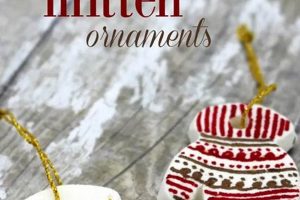These collections provide the materials and instructions necessary for individuals to create personalized decorations for the holiday season. They typically include a variety of components such as unfinished wooden shapes, paints, glitter, beads, felt, and glue, allowing for a wide range of creative expression. An example might be a set containing small wooden stars, red and green paint, and twine for hanging on a Christmas tree.
The practice of crafting decorations holds significance beyond mere aesthetics. It provides an opportunity for creative engagement, fostering a sense of accomplishment and personalized tradition. The resulting items often become cherished keepsakes, carrying sentimental value and recalling memories associated with their creation. Historically, handmade ornaments were commonplace due to limited access to mass-produced goods, highlighting the resourceful and inventive spirit of individuals during festive celebrations.
Subsequent sections will explore the different types of these collections available, considerations for selecting appropriate kits, and ideas for maximizing the creative potential offered within.
Tips for Selecting and Utilizing DIY Christmas Ornament Kits
The following guidelines offer insight into choosing and effectively using these creative sets for optimal results and enjoyment.
Tip 1: Assess Skill Level and Age Appropriateness: Evaluate the complexity of the project and the dexterity required. Choose kits suited to the participant’s experience to prevent frustration. For young children, opt for larger pieces and non-toxic materials.
Tip 2: Review Material Quality and Quantity: Examine the included materials. Ensure sufficient paint, glue, and embellishments are provided to complete the designated projects. Low-quality materials may compromise the finished product’s appearance and durability.
Tip 3: Consider Design and Theme Preferences: Select kits that align with desired aesthetic styles and holiday themes. A cohesive look on the Christmas tree or within the home enhances the overall decorative impact.
Tip 4: Read Instructions Carefully Before Starting: Thoroughly review all instructions before commencing the project. This step minimizes errors and ensures proper execution of each step.
Tip 5: Protect Work Surfaces: Cover the work area with a protective barrier to prevent spills and damage from paint, glue, and glitter. Newspaper, craft mats, or plastic sheeting are suitable options.
Tip 6: Allow Adequate Drying Time: Adhere to recommended drying times for paint and glue. Rushing this process can lead to smudging, incomplete adhesion, and compromised finished results.
Tip 7: Embellish and Personalize Projects: While following the basic instructions, incorporate individual creative touches. Add unique embellishments, customize colors, or alter designs to create truly original ornaments.
These recommendations will facilitate the selection of suitable collections and encourage effective utilization, resulting in satisfying creative endeavors and uniquely personalized holiday adornments.
The subsequent section concludes this exploration with insights into storing finished products to protect craftsmanship for years to come.
1. Material Quality
Material quality directly influences the longevity and aesthetic appeal of completed decorations. Inferior components within a “diy christmas ornament kit” can lead to several adverse outcomes. Substandard paints may exhibit poor coverage, fading, or cracking, diminishing the ornament’s visual impact over time. Low-grade adhesives can result in embellishments detaching, compromising the structural integrity of the creation. The quality of the base material, such as wood or plastic, also matters significantly; cheap materials are more susceptible to breakage or warping.
The significance of material quality extends beyond mere aesthetics. Durable materials ensure the ornaments can be stored and reused for multiple holiday seasons, creating lasting traditions and minimizing waste. For instance, a kit containing high-quality acrylic paints and sturdy wooden shapes allows for the creation of ornaments that resist fading and damage, becoming cherished family heirlooms. Conversely, a kit with thin, easily breakable plastic and water-based paints may produce ornaments that are quickly discarded after a single season.
Understanding the impact of material quality is essential for both manufacturers and consumers. Manufacturers must prioritize durable and visually appealing components to offer value and customer satisfaction. Consumers should carefully examine kit contents before purchasing, considering the long-term implications of material choices. Prioritizing quality leads to sustainable and meaningful holiday traditions, enhancing the overall experience of creating personalized decorations.
2. Design Complexity
Design complexity within a “diy christmas ornament kit” directly influences the target audience and achievable aesthetic outcome. Kits intended for young children typically feature simplified designs with large, easily manipulated components, minimizing fine motor skill requirements and potential frustration. Conversely, kits targeted at adults or experienced crafters often incorporate intricate patterns, demanding precision and dexterity. The level of complexity dictates the time investment required and the potential for elaborate, personalized creations. A kit containing pre-cut felt shapes for a snowman, for instance, represents low design complexity, while a kit involving intricate beadwork and wire shaping represents high design complexity. The choice of design complexity must align with the intended user’s skill set and desired level of engagement.
The importance of matching design complexity to skill level extends to the overall success of the crafting experience. A design that is too simple may be perceived as uninteresting or lacking in creative potential, while one that is overly complex can lead to discouragement and project abandonment. Manufacturers must carefully consider the skill levels of their target demographic and calibrate the complexity of the designs accordingly. Furthermore, the level of instruction provided should be commensurate with the design’s intricacy; clear, detailed instructions are essential for navigating complex steps and achieving the intended result. The impact of design complexity also extends to the final product; more intricate designs often result in visually impressive ornaments that are highly valued as handcrafted keepsakes.
Understanding the interplay between design complexity, target audience, and instructional clarity is crucial for maximizing the value of “diy christmas ornament kits.” Carefully calibrated designs, appropriate for the intended user and supported by comprehensive instructions, contribute to a satisfying and rewarding crafting experience. Overly complex designs lacking sufficient guidance diminish the likelihood of successful project completion. Recognizing this connection is essential for manufacturers aiming to create appealing and accessible crafting experiences, and for consumers seeking kits that align with their skills and aspirations.
3. Personalization Options
The availability of personalization options within a “diy christmas ornament kit” directly impacts its perceived value and capacity to foster individual creativity. The degree to which a kit allows for deviation from pre-determined designs influences the uniqueness and sentimental value of the resulting ornaments. A kit offering a limited range of paint colors and pre-cut shapes inherently restricts personalization, resulting in ornaments that are largely uniform. Conversely, a kit containing a wide spectrum of paints, a variety of embellishments, and templates for diverse shapes facilitates the creation of distinct, individualized decorations. This degree of personalization is a critical factor in the appeal of these kits, particularly for those seeking to create truly unique and meaningful holiday keepsakes. For example, a basic kit might offer only red and green paint, limiting creativity, while an advanced kit could provide a palette of metallic paints, glitter, beads, and stencils, enabling personalized designs reflecting individual interests or family traditions.
The impact of personalization extends beyond mere aesthetics; it fosters a deeper connection between the creator and the ornament. When individuals can freely express their creativity through personalized designs, the resulting ornaments become tangible representations of their individual style and memories. These personalized items carry significantly greater emotional weight than mass-produced decorations. Moreover, personalization options cater to a wider range of skill levels and creative preferences. Some individuals may prefer to adhere closely to provided templates, while others will seek to completely reimagine the provided materials. By offering diverse personalization opportunities, manufacturers broaden the appeal and user satisfaction associated with their “diy christmas ornament kits”. An understanding of the end-users expectations for creativity and design choice is therefore a pivotal step in the development and marketing of DIY christmas ornament kits.
In summary, personalization options are a central determinant of a “diy christmas ornament kit’s” value and its ability to inspire creativity and meaningful engagement. Limiting personalization diminishes the potential for unique and cherished ornaments. Maximizing personalization, through a wide array of materials and design possibilities, elevates the crafting experience and generates ornaments that are distinct representations of individual expression. While balancing ease of use with creative freedom presents a design challenge, the ability to personalize ornaments remains a key factor in the enduring appeal and practical success of “diy christmas ornament kits.”
4. Age Suitability
The age suitability of a “diy christmas ornament kit” is a critical factor influencing safety, engagement, and project success. Selecting a kit that is inappropriate for the user’s developmental stage can lead to frustration, potential hazards, and ultimately, a negative crafting experience. Considerations extend beyond mere physical safety to encompass cognitive and emotional development, ensuring the activity is both enjoyable and developmentally appropriate.
- Small Parts and Choking Hazards
Kits designed for older children or adults may contain small beads, sequins, or other components that present a choking hazard to younger children. Manufacturers should clearly label such kits with age recommendations and warnings regarding small parts. Supervision by an adult is essential when younger children are participating in crafting activities, even with age-appropriate kits.
- Complexity of Instructions and Fine Motor Skills
The complexity of the instructions and the fine motor skills required to assemble the ornaments are vital considerations. Kits requiring intricate knotting, precise cutting, or the application of small embellishments are generally better suited for older children and adults with well-developed fine motor skills. Younger children benefit from kits with larger, easier-to-manipulate components and simplified instructions. Kits should be chosen based on these considerations.
- Toxicity of Materials
The materials included in the kit must be non-toxic, particularly for kits intended for younger children. Paints, glues, and other embellishments should be certified as safe and free from harmful chemicals. Water-based paints are generally preferred for children’s kits, as they are less likely to cause irritation or allergic reactions. Clear labeling and adherence to safety standards are essential for ensuring the safety of the kit’s contents.
- Supervision and Guidance Requirements
The level of supervision and guidance required to complete the project should also be considered. Younger children typically require more guidance and assistance than older children or adults. Kits designed for younger children should include clear, step-by-step instructions that are easy to follow. Adult supervision is essential to ensure safety and to assist with any challenging steps. Kits should be selected to meet the time commitment available.
Age suitability is, therefore, a multifaceted consideration when selecting a “diy christmas ornament kit.” Factors relating to component hazards, the need for complex instructions, toxicity of materials and supervisory commitments combine to define the appropriateness of the set. By carefully considering these aspects, purchasers can ensure a safe, enjoyable, and fulfilling crafting experience for all participants.
5. Instruction Clarity
The efficacy of a “diy christmas ornament kit” hinges significantly on the clarity of its included instructions. Ambiguous or incomplete instructions can lead to frustration, project abandonment, and a perceived lack of value. Conversely, well-written, easily understood instructions empower users to successfully complete the project, fostering a sense of accomplishment and satisfaction. A direct causal relationship exists between instruction clarity and user experience; unclear instructions increase the likelihood of errors and dissatisfaction, while clear instructions promote successful project completion and positive sentiment. Instruction clarity operates as a pivotal component within a “diy christmas ornament kit,” influencing its overall usability and perceived quality. For example, instructions that lack detailed diagrams or fail to specify precise quantities of materials can impede the creation process, even for experienced crafters.
Practical examples of this principle abound. A kit intended for children might feature instructions relying heavily on visual aids, such as numbered diagrams demonstrating each step. These instructions will emphasize minimal text to avoid overwhelming young users. A more complex kit targeted at adults could utilize written instructions with detailed explanations and technical terminology. The key element remains consistent: information is presented in a manner easily digestible by the intended audience. Furthermore, quality control measures during the kit development process can mitigate issues related to instruction clarity. Employing beta testers to evaluate the instructions and provide feedback allows manufacturers to identify and address potential points of confusion before the kit reaches the market. This process is vital for ensuring that instructions align with the user’s expectations.
In conclusion, instruction clarity functions as a determining factor in the success and consumer satisfaction associated with “diy christmas ornament kits.” Poorly written or incomplete instructions undermine the potential benefits of the kit, leading to negative experiences and a diminished perception of value. Conversely, clear, concise, and user-friendly instructions enable successful project completion, fostering creativity and positive associations with the crafting experience. Effective implementation of instruction clarity principles requires a deep understanding of the target audience and a commitment to rigorous quality control measures. Ensuring optimal instruction clarity represents a fundamental step towards maximizing the value and appeal of these decorative crafting kits.
Frequently Asked Questions
This section addresses common inquiries and concerns regarding the selection, use, and storage of ornament crafting sets. The information provided aims to offer clarity and assist in informed decision-making.
Question 1: What are the primary factors to consider when evaluating the suitability of a DIY Christmas ornament kit for children?
Age appropriateness, material safety, and complexity of design are paramount. Small parts pose choking hazards for young children. Materials must be non-toxic. Designs should be simple and easy to manipulate, promoting successful project completion and avoiding frustration. Adult supervision is recommended, particularly for kits involving cutting or gluing.
Question 2: How can material quality impact the longevity of finished ornaments?
Substandard materials, such as low-grade paints or flimsy bases, compromise the durability and aesthetic appeal of ornaments. Inferior paints may fade, crack, or exhibit poor coverage. Bases made from inexpensive materials are prone to breakage or warping. High-quality materials ensure that ornaments retain their appearance and structural integrity over time, becoming lasting keepsakes.
Question 3: What are the benefits of personalization options within a DIY Christmas ornament kit?
Personalization enhances the perceived value and sentimental worth of ornaments. Kits offering diverse paint colors, embellishments, and design templates allow for individual expression. The ability to customize ornaments fosters a deeper connection between the creator and the finished product. This personalization opportunity transforms generic ornaments into tangible representations of individual style and memories.
Question 4: How does design complexity influence the user experience?
Designs that are too simple may be perceived as uninteresting, while designs that are overly complex can lead to discouragement and project abandonment. Design complexity should align with the user’s skill level and desired level of engagement. Intricate designs require precision and dexterity. Manufacturers should calibrate design complexity to the target demographic, providing detailed instructions commensurate with the design’s intricacy.
Question 5: What are the best practices for storing finished Christmas ornaments to prevent damage?
Store ornaments in a cool, dry place away from direct sunlight. Individual compartments or padded storage containers prevent scratches and breakage. Acid-free tissue paper can protect delicate surfaces. Avoid stacking heavy objects on top of ornament storage containers. Proper storage ensures that ornaments remain in good condition for future use.
Question 6: Are there eco-friendly DIY Christmas ornament kit options available?
Yes, there are kits that utilize recycled materials, sustainable wood, and non-toxic, water-based paints. Kits employing biodegradable glitter and compostable packaging further reduce environmental impact. Consumers concerned with sustainability should look for kits that prioritize environmentally responsible materials and manufacturing processes.
Understanding these key points facilitates a better understanding of the diverse options and factors associated with these kits.
The succeeding segment explores trends in ornament design, including popular materials, styles, and themes for the coming holiday season.
Conclusion
This exploration has underscored the multifaceted nature of “diy christmas ornament kits,” emphasizing factors ranging from material quality and design complexity to personalization options and user age suitability. Successful utilization of these kits necessitates careful consideration of these variables to ensure a positive and productive crafting experience. The economic value, the educational or sentimental value are important too.
The continued prevalence and adaptation of these creative sets suggest their enduring appeal. As manufacturing techniques evolve and consumer preferences shift, “diy christmas ornament kits” will likely continue to offer opportunities for personalized expression and the creation of cherished holiday keepsakes, if the kits are manufactured well and match the consumers preferences. The future of this set would be great and bright.







